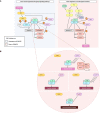E2F1: Cause and Consequence of DNA Replication Stress
- PMID: 33665206
- PMCID: PMC7921158
- DOI: 10.3389/fmolb.2020.599332
E2F1: Cause and Consequence of DNA Replication Stress
Abstract
In mammalian cells, cell cycle entry occurs in response to the correct stimuli and is promoted by the transcriptional activity of E2F family members. E2F proteins regulate the transcription of S phase cyclins and genes required for DNA replication, DNA repair, and apoptosis. The activity of E2F1, the archetypal and most heavily studied E2F family member, is tightly controlled by the DNA damage checkpoints to modulate cell cycle progression and initiate programmed cell death, when required. Altered tumor suppressor and oncogenic signaling pathways often result in direct or indirect interference with E2F1 regulation to ensure higher rates of cell proliferation independently of external cues. Despite a clear link between dysregulated E2F1 activity and cancer progression, literature on the contribution of E2F1 to DNA replication stress phenotypes is somewhat scarce. This review discusses how dysfunctional tumor suppressor and oncogenic signaling pathways promote the disruption of E2F1 transcription and hence of its transcriptional targets, and how such events have the potential to drive DNA replication stress. In addition to the involvement of E2F1 upstream of DNA replication stress, this manuscript also considers the role of E2F1 as a downstream effector of the response to this type of cellular stress. Lastly, the review introduces some reflections on how E2F1 activity is integrated with checkpoint control through post-translational regulation, and proposes an exploitable tumor weakness based on this axis.
Keywords: DNA replication stress; E2F1; cyclin E; cyclin F; retinoblastoma; ribonucleotide reductase; ubiquitin proteasome system.
Copyright © 2021 Fouad, Hauton and D'Angiolella.
Conflict of interest statement
The authors declare that the research was conducted in the absence of any commercial or financial relationships that could be construed as a potential conflict of interest.
Figures


Similar articles
-
Roles of E2F1 in mesangial cell proliferation in vitro.Kidney Int. 1999 Dec;56(6):2085-95. doi: 10.1046/j.1523-1755.1999.00799.x. Kidney Int. 1999. PMID: 10594784
-
Regulation of the G1/S transition phase in mesangial cells by E2F1.Kidney Int. 1999 Oct;56(4):1238-41. doi: 10.1046/j.1523-1755.1999.00705.x. Kidney Int. 1999. PMID: 10504464 Review.
-
Regulation of the cyclin D3 promoter by E2F1.J Biol Chem. 2003 May 9;278(19):16770-6. doi: 10.1074/jbc.M212702200. Epub 2003 Feb 28. J Biol Chem. 2003. PMID: 12611887
-
Cell proliferation in the absence of E2F1-3.Dev Biol. 2011 Mar 1;351(1):35-45. doi: 10.1016/j.ydbio.2010.12.025. Epub 2010 Dec 23. Dev Biol. 2011. PMID: 21185283 Free PMC article.
-
Introduction to the E2F family: protein structure and gene regulation.Curr Top Microbiol Immunol. 1996;208:1-30. doi: 10.1007/978-3-642-79910-5_1. Curr Top Microbiol Immunol. 1996. PMID: 8575210 Review.
Cited by
-
E2F1 Mediates Traumatic Brain Injury and Regulates BDNF-AS to Promote the Progression of Alzheimer's Disease.Neurotox Res. 2024 Feb 22;42(2):17. doi: 10.1007/s12640-024-00695-2. Neurotox Res. 2024. PMID: 38386202
-
Bioinformatics analysis of the prognostic and clinical value of senescence-related gene signature in papillary thyroid cancer.Medicine (Baltimore). 2023 Jun 2;102(22):e33934. doi: 10.1097/MD.0000000000033934. Medicine (Baltimore). 2023. PMID: 37266618 Free PMC article.
-
Clinical evidence for a role of E2F1-induced replication stress in modulating tumor mutational burden and immune microenvironment.DNA Repair (Amst). 2023 Sep;129:103531. doi: 10.1016/j.dnarep.2023.103531. Epub 2023 Jun 30. DNA Repair (Amst). 2023. PMID: 37453246 Free PMC article.
-
Transcriptomic landscape of quiescent and proliferating human corneal stromal fibroblasts.Exp Eye Res. 2024 Nov;248:110073. doi: 10.1016/j.exer.2024.110073. Epub 2024 Sep 5. Exp Eye Res. 2024. PMID: 39243928
-
E2F1 Expression and Apoptosis Initiation in Crayfish and Rat Peripheral Neurons and Glial Cells after Axonal Injury.Int J Mol Sci. 2022 Apr 18;23(8):4451. doi: 10.3390/ijms23084451. Int J Mol Sci. 2022. PMID: 35457270 Free PMC article.
References
-
- Banerjee D., Schnieders B., Fu J. Z., Adhikari D., Zhao S. C., Bertino J. R. (1998). Role of E2F-1 in chemosensitivity. Cancer Res. 58, 4292–4296. - PubMed
Publication types
Grants and funding
LinkOut - more resources
Full Text Sources
Other Literature Sources

